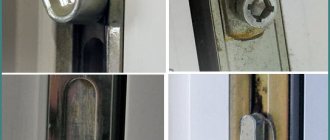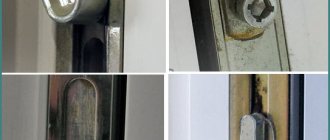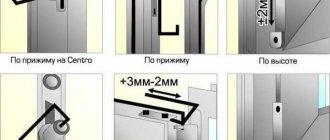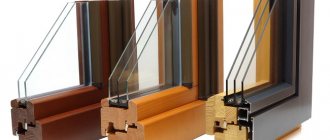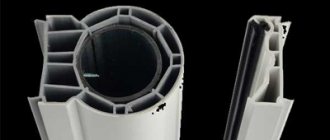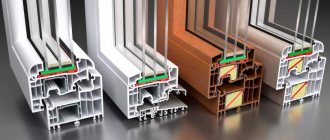Modern fittings for plastic windows provide the ability to adjust the sash pressure. The operating mode is determined by the clamping force. There are three modes in total: weak (summer), strong (winter) and medium (standard). They need to be used wisely, taking into account the current state of the structure and the level of comfort in the room. If there is a need to switch the shutters to winter mode, you should determine the type of eccentrics and study the instructions below for adjusting them.
Why is adjustment needed?
When installing plastic windows, the technician can set any mode. Experts focus on the season, but it is still recommended to find out information regarding the clamping force, because this affects the degree of wear of the structure.
Window adjustment is a responsible process
Table 1. Adjustment modes for plastic windows.
| Type | Description |
| Summer | The polymer seal is not under pressure. The sash fits tightly to the surface without gaps, but does not press the rubber too much. The advantage of this method of operation is the ability to use the seal for many years. Thus, even a plastic structure can shrink and expand depending on weather conditions, while the welded joints are not subject to heavy loads. |
| Standard | This method involves minimal pressure on the seal, so there will be no drafts or noise in the room. In some regions of our country, this regime is set all year round. However, the rubber will wear out much faster. |
| Winter | In this case, the rubber is under high pressure. This can be recognized by the characteristic (tight) turning of the handle to the side. If you use this mode constantly, the seal will quickly lose its shape and will have to be replaced. So, if, after pressing, you switch the windows to summer or standard mode, then drafts will appear. |
Position of the mechanism for different types of modes
Of all the possible ones, only the “summer” mode is considered gentle - this means that it does not contribute to tire wear. Therefore, if residents do not experience discomfort, then it can be used all year round - this way it will be possible to extend the service life of the seal.
However, there are reasons why it is recommended to constantly change the seal pressure:
- draft - residents are unlikely to like the appearance of cold air from the window in winter and dust in the summer;
- problems when opening and closing the sash - if the mode is incorrectly set, the sash sometimes jams;
- sagging of the window sash - occurs as a result of wear of the hinges, this problem can be solved by switching to the strong pressure mode;
- loss of warm air - windows are adjusted to save money on heating;
- mold on the window frame and slopes - this problem is associated with excessive dampness due to poor sealing.
Incorrect adjustment may result in mold formation.
There are some rules for using modes:
- Using a plastic window with strong pressure is only allowed for a short period of time. Most often, the seal is tightened at the end of November, and loosened by March.
- “Winter” mode is strictly prohibited from being used in summer. Otherwise, this will lead to rapid wear of the rubber and the metal-plastic structure itself, because when heated, all parts expand, which is why the welded joints suffer.
When using the “winter” mode in summer, the structure quickly deforms - For the first 12-24 months after installing the windows, it is recommended to constantly use the “summer” mode, because the new seal perfectly protects the room from drafts and other inconveniences.
How to check the tightness of windows?
How to figure out what mode the window is in right now
There are two such methods:
- Use paper as an indicator of the force of pressing the sash against the frame.
The edge of this leaf needs to be placed between the sash and the frame during the closing process, and then assess the degree of clamping by trying to pull it out. Easy removal of the sheet indicates that the window fittings are adjusted to summer mode. If the sheet is pulled out with great effort, or at best, it doesn’t stretch out at all, breaking off, then the adjustment is winter.
- Study the location of the trunnions (eccentrics).
The round pin usually contains a dash, dot or asterisk, which helps to recognize the set mode. In oval fittings, the degree of rotation is taken into account.
The second method will become more clear after familiarizing yourself with the types of trunnions in the next section.
Adjusting plastic windows for winter mode
Switching windows from one mode to another is simple, but you will have to pay attention to each stage. Some people are completely afraid to perform this procedure, so they use the services of a company that installs windows. If there is a lot of pressure, the rubber quickly becomes unusable, and you can unknowingly ruin an expensive double-glazed window. But if you approach the process thoughtfully, there will be no problems.
Adjusting trunnions on metal-plastic windows: step-by-step instructions
Step one: first you need to find where the trunnions are located. Usually their number depends on the dimensions of the structure. However, most often there are three of them on one side (where the handle is located) and one on the other side.
In case of mode change, each trunnion must be adjusted
Step two: Next, you need to pay attention to cleaning the window and fittings so that dirt does not get into the trunnions.
The window must be clean
Step three: now you need to wipe the lubricant elements with a cloth, and then apply it to the surface
Machine oil can be used for lubrication
Step four: now you should examine the condition of the trunnions, find marks on them and turn them to the desired position.
For such purposes, use a hexagon or pliers.
Step five: upon completion of installation, you need to check the tightness again using a paper sheet, as we described above.
Even with increased impact, the paper sheet must remain between the frame and the sash
Note! Some companies make windows with recessed trunnions, so you will need to pull them out with the same pliers before making adjustments. Otherwise, this procedure resembles changing a clock.
If necessary, you can loosen the eccentrics in the same way, which means switching the windows to summer or standard mode. It is enough to do this procedure several times, and you will definitely not confuse the modes.
Prices for plastic windows
Plastic windows
Video – Adjusting windows by mode
Alternative ways to adjust windows
There are cases when, after switching to the “winter” mode, drafts are still observed. Most often this happens when some parts of the sash are distorted. A similar problem occurs over time when the glass unit wears out.
Adjusting the window sash according to planes
To set the correct position for the sash, you need to find the locations of the adjustment screws.
Tools you will need are a hex wrench and a flat-head screwdriver. Just first you need to remove the caps that are located on top of the hinges - it is better to do this at a time when the sash is slightly open.
The hinge caps look like this:
Table 3. Alternative methods for adjusting plastic windows.
| Method, illustration | Description |
| Vertical | It is necessary to turn the screw from above on the bottom hinge. To lift the sash, turn it to the right. |
| Horizontally | Adjustment is carried out by turning the last screw on the hinge from below. When turning to the right, the frame moves a little closer to the hinges. Since the fastener is located close to the slope, it can be difficult to get to. |
| Bottom corner | This adjustment is made by turning the bottom screw of the bottom hinge. It is not installed on all windows. Do not confuse it with the previous screw. |
| Top corner | You will need to rotate the upper axle. To do this, the window is opened in several positions at once: tilting and rotating. If the mark on the eccentric is directed towards the sash, then the seal is pressed as much as possible. |
| By counter strips | During the use of a double-glazed window, these structural elements unwind, so they should be adjusted. |
You should not make many turns at once, because you need to constantly monitor the position of the sash so as not to overtighten or loosen. Experts do not recommend using such adjustment methods for users who have no experience in this area - without calculating the force, you can easily damage the window design. Upon completion of this process, it is necessary to ensure that the sash does not cling to the plastic frame.
How to adjust it yourself?
The basic rule when setting the modes of a plastic window is that if there are several trunnions on the sash, then they must be twisted into an identical position, otherwise an uneven fit will occur, in which not only the desired mode will not work, but this will eventually cause distortion and sagging.
Switching modes in Rehau windows is usually very standard and familiar for these designs - the trunnion is rotated so that the mark (or the end of the oval lever) on it faces in a certain direction:
- First option:
- up, strictly in the center or with a slight tilt towards the room - average mode (standard, neutral, spring-autumn);
- to the left (towards the street) – winter;
- to the right (towards the room) – summer.
- Second option:
- towards the room - winter;
- down the center – neutral;
- towards the street - summer.
- If there is special fittings and the adjustment is made not by turning the lever, but by moving it down/up, which is rare, but still sometimes occurs, then the values are as follows: top position - summer, middle - neutral, bottom - winter.
- Some manufacturers recess the trunnions, that is, the lever must first be pulled out, turned and pushed back.
- If the eccentric is oval-shaped : summer (weak pressure) – the ends are vertical; neutral (middle) – vertically, but the upper end at a slight angle towards the room; winter (strong) – ends horizontally. There may be different options, so you should read the instructions for a specific model of fittings, and you can easily find such information on a specific harness on the Internet.
When you turn the lever, you can see how it changes its horizontal position: it approaches or moves away from the edge of its seat, as it moves along with the fittings for more or less pressure. Intermediate regimes are also possible, but you should consult with specialists about their advisability.
The handle does not turn to the desired position: repair features
This problem occurs for the following reasons:
- After long-term use, the structure needs to be cleaned and lubricated, so it must be disassembled into small parts, remove dirt, and then lubricate it with oil and a thin brush.
- If the handle turns only up to a certain point and then jams, you should slightly loosen the sash clamp. In this case, the trunnions that are located nearby are rotated. There are hinges on the other side; it is also recommended to adjust the bolts in them.
The handle is blocked: adjustment method
Some users, when the handle is blocked, rush to replace it with a new one, but this is not always necessary. In this case, you don’t even need to unscrew it and disassemble it into parts, because the problem is related to the locking device, which prevents the sash from changing its position when open. You just need to turn the lever to the side.
Schematic representation of the locking device
There are two ways to fix this problem. So, in the first case, the lever is located at an angle to the rubber (in the form of a tongue). In the second case, it looks like a clamp that is located above the seal.
Handle breakage
If the handle is broken, then it will no longer be possible to return it to its previous appearance - all that remains is to purchase a new one. It is not difficult to dismantle the previous one, just unscrew the screws and pull it towards you. Next, all that remains is to attach the new handle.
Window fittings are available for sale in various hardware stores.
Prices for various types of handles for plastic windows
Handle for plastic window
Why adjust PVC windows
| Timely adjustment of Rehau structures is part of their maintenance. It helps to extend the life of the structure and make it as comfortable as possible. For example, adjusting Rehau windows to winter and summer positions helps to increase the pressure density and retain heat during the cold season. And in warm weather - reduce the load on the mechanisms, extending their service life. If a sash misalignment is detected in a timely manner, you can also correct it yourself. Comfortable use of the structure is out of the question if the handles dangle or you have to exert significant effort to open the doors. |
Difficulties in adjustment
There are some mistakes that users often make when switching to “winter” mode:
- It is not recommended to move a completely new double-glazed window into this position, because with strong compression the rubber can be irrevocably deformed.
- The compression of the seal should be the same on each side, so this should be checked with the same sheet of paper - this is a common cause of rubber damage.
The problem with the window is not always related to the wrong mode
Sometimes, even with correct window adjustments, the following problems arise:
- drafts;
- condensation accumulation;
- hypothermia of the room.
Such troubles are preceded by reasons:
- Factory design defect. This happens in exceptional cases, especially when ordering windows from suspicious companies.
- Installation errors. Window installation should only be trusted by a qualified craftsman, because you will need to maintain the correct gaps, carefully connect all the elements, and also use polyurethane foam.
- Lack of slope finishing. After installing the windows, finishing of the slopes will be required - the mounting foam loses strength when exposed to moist air or sunlight.
- The seal has become unusable. Even if this is a relatively new window, the rubber may lose its elasticity within a couple of seasons (if used improperly).
If a manufacturing defect is detected, you should contact the company’s specialists to receive compensation.
Features of restoration and replacement of seals (rubber bands)
Unfortunately, over time, all elements of a plastic window fail, and in particular the elastic polymer seals. The cause of this problem is pollution, dampness, and lack of regular lubrication.
If the elastic bands are no more than four to five years old, then you can try to revive them. To do this, you will need to dismantle the seals, then take a few rags and thoroughly soap them. Products are wrapped in these rags and left in this form for several hours. Sometimes such an experiment allows one to achieve stunning results, so it is allowed to be carried out for the purpose of “prevention”.
The need to replace sealing strips arises in the following cases:
- loss of color;
- the appearance of “bumps” on the surface;
- multiple cracks.
A seal with multiple damages cannot be repaired.
In this case, all that remains is to purchase a new seal - usually its thickness is from 3 to 6.5 millimeters. Most often, manufacturers guarantee a service life of up to 10 years, but in practice the rubber dries out much earlier.
Note! A high-quality seal should not become an obstacle to the circulation of oxygen, so you need to look at its composition - it must be breathable.
Prices for seals for plastic windows
Sealant for plastic windows
Video - Replacing the seal
Which systems are better, Veko or rehau: expert opinion
Today, metal-plastic double-glazed windows of the Rehau and Veko brands are popular. And many people have a question about which brand to give preference to. To answer this, you need to compare the products of two manufacturers according to different characteristics, in particular, strength, safety, reliability, thermal insulation, durability, waterproofing, sound insulation, as well as aesthetics, and a variety of profiles. This will make it easier to identify the leader.
Both companies produce high-quality profiles that are suitable for use in domestic climatic conditions. Rehau has a wide range of products. The manufacturer's line includes blocks of different sizes, for all occasions. It’s easy to choose an option to suit your existing budget level.
The German company Rehau produces the following three-, four-, five- and six-chamber profiles:
- Three-chamber, 6 cm. Its thermal insulation value is 0.64 m2°C/W. Blitz is an excellent economy class option.
- EURO-Design. Three-chamber, 6 cm deep. There are two sealing contours. Therefore, it provides better thermal insulation. The surface is perfectly smooth.
- SIB-Design. Three-chamber, with a depth of 7 cm. There is an additional thermoblock. An ideal model for the domestic climate control market.
- This is a five-chamber variety with a depth of 7 cm. It has high thermal insulation properties (0.85 m2 ° C / W) and an elegant, beautiful appearance.
- DELIGHT-Design. Five-chamber, 7 cm. Provides more light penetration into the room (by 10%) due to its design features. Thermal insulation is at the level of 0.8 m2°C/W. Burglary-proof, with good air and water resistance.
- BRILLANT-Design. Premium option. May be five or six chambered. The depth varies between 70-80 mm. The structure is distinguished by an exclusive design. It is developed using innovative technologies. It is characterized by high heat, hydro and noise insulation qualities.
- This is a six-chamber premium option with a depth of 80 or 86 mm. It has fourth class sound insulation. The thermal insulation value reaches 0.95 m2°C/W. The design is burglary-proof (class 3).
- Six-chamber, 86 mm. Innovative reinforcement technology was used. The heat retention rate is 1.05 m2°C/W. The model is characterized by excellent sound insulation (class 5). Available in different designs.
Veka is also a German company. But she is younger. Offers the following profile models:
- Three-chamber, 58 mm. Has sufficient thermal insulation (0.64 m2°C/W). Not a bad economical option.
- Four-chamber, 70 mm. Thermal insulation value is 0.75 m2°C/W. It also has good sound insulation.
- Five-chamber version with thermal insulation at the level of 0.78 m2°C/W and high sound insulation (class 2-4).
- Five-chamber, 70 mm. It is distinguished by rounded shapes on the outside. Thermal insulation value is 0.77 m2°C/W.
- SoftLine 82. A decent premium option, with six or seven cameras. Has a depth of 82 mm. Thermal insulation value is 1.09 m2°C/W. Double-glazed windows up to 52 mm.
- Premium plastic six-chamber, 82 mm. Looks elegant. Simulates “blind doors”. Heat transfer resistance is 1.11 m2°C/W.
- Premium six-chamber plastic 9 cm deep. Suitable for double-glazed windows up to 5 cm. There is a seal along three contours. The design has high thermal insulation (1.04 m2°C/W), increased safety and improved sound insulation. Available in 40 shades.
Comparison of products from two manufacturers:
- Veka profiles are offered in more interesting design solutions for different interiors.
- The quality of the Eyelid is better. The products of this brand last longer.
- In terms of insulation characteristics, both manufacturers produce decent products.
- The designs of both companies meet international standards.
- The cost of plastic double-glazed windows is lower at Rehau.
- In terms of ease of setup and maintenance, Rehau products are the leaders. It is possible to adjust plastic windows yourself.
- Rehau produces lighter profiles through the use of bulk plastic reinforcement technology.
It is difficult to say which manufacturer's double-glazed windows are best to install. According to some indicators, Rehau is the leader, and according to others, Veka. But many give preference to the first brand due to the lower cost of products. If you plan to customize the structure yourself during operation, it is better to choose Rehau.
Let's sum it up
Every person can cope with adjusting plastic windows according to the season, because this process is not difficult. Moreover, you will only need a minimum set of devices, which can be found in the arsenal of any master.
Otherwise, changing modes is a mandatory procedure that will avoid overcooling the room and rapid wear of the seal. It is recommended to use the window carefully - avoid twisting the handles and overloading the sashes.
To remove glazing beads from a plastic window, no special skills are required; in a special article you will learn simple methods for dismantling and installing glazing beads, and you can also read step-by-step instructions.
Blowing
To eliminate drafts, you need to adjust the mechanism of plastic windows.
At the end of the window there are eccentrics, with the help of which the fit of the sash is adjusted.
By turning the hexagon to the left, the fit is tightened, and in the opposite direction, it is loosened. It is important that the fit is uniform and tight, for which the eccentrics are set equally.
When adjusting the pressure of a plastic window is done for the first time, an easy adjustment is made. The fact is that the rubber bands of the seal tend to shrink and deteriorate. If you press the sash hard during the first adjustment, the rubber bands will dry out faster, and subsequently you will have to change the seal.
In some mechanisms, the sash is pressed using plates. An extended tongue in the clamping mechanism means that the sash is firmly attached to the frame. On hinges located on the left side of the window, for a tight fit, the hexagon turns to the left side, and to the right - if the hinges are located on the right side.
Return to content
